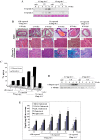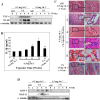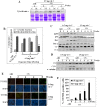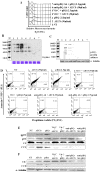Molecular and cellular mechanisms of cigarette smoke-induced myocardial injury: prevention by vitamin C
- PMID: 22970172
- PMCID: PMC3435405
- DOI: 10.1371/journal.pone.0044151
Molecular and cellular mechanisms of cigarette smoke-induced myocardial injury: prevention by vitamin C
Abstract
Background: Cardiovascular disease (CVD) remains one of the major killers in modern society. One strong risk factor of CVD is cigarette smoking that causes myocardial injury and leads to the genesis of pathological cardiovascular events. However, the exact toxic component(s) of cigarette smoke (CS) and its molecular and cellular mechanisms for causing myocardial injury leading to heart damage and its prevention are largely unknown.
Methodology/principal findings: Using a guinea pig model, here we show that chronic exposure to CS produces myocardial injury that is prevented by vitamin C. Male guinea pigs were fed either vitamin C-deficient (0.5 mg/day) or vitamin C-sufficient (15 mg/day) diet and subjected to CS exposure from 5 Kentucky Research cigarettes (3R4F)/day (6 days/week) in a smoke chamber up to 8 weeks. Pair-fed sham controls were subjected to air exposure instead of CS exposure under similar conditions. Myocardial injury was produced in CS-exposed marginal vitamin C-deficient guinea pigs as evidenced by release of cardiac Troponin-T and I in the serum, oxidative stress, inflammation, apoptosis, thrombosis and collagen deposition in the myocardium. Treatment of rat cardiomyocyte cells (H9c2) in vitro and guinea pigs in vivo with p-benzoquinone (p-BQ) in amounts derived from CS revealed that p-BQ was a major factor responsible for CS-induced myocardial damage. A moderately large dose of vitamin C (15 mg/day) prevented CS/p-BQ-induced myocardial injury. Population based studies indicated that plasma vitamin C levels of smokers without disease were significantly lower (p = 0,0000) than that of non-smokers. Vitamin C levels of CS-related cardiovascular patients were further lower (p = 0.0000) than that of smokers without disease.
Conclusions/significance: The results indicate that dietary supplementation of vitamin C may be a novel and simple therapy for the prevention of pathological cardiovascular events in habitual smokers.
Conflict of interest statement
Figures







Similar articles
-
Causation of cigarette smoke-induced emphysema by p-benzoquinone and its prevention by vitamin C.Am J Respir Cell Mol Biol. 2015 Mar;52(3):315-22. doi: 10.1165/rcmb.2013-0545OC. Am J Respir Cell Mol Biol. 2015. Retraction in: Am J Respir Cell Mol Biol. 2021 Apr;64(4):519. doi: 10.1165/rcmb.v64retraction8. PMID: 25057895 Retracted.
-
Vitamin C prevents cigarette smoke-induced oxidative damage in vivo.Free Radic Biol Med. 2000 Jul 15;29(2):115-24. doi: 10.1016/s0891-5849(00)00297-5. Free Radic Biol Med. 2000. PMID: 10980400
-
Vitamin C prevents cigarette smoke induced atherosclerosis in guinea pig model.J Atheroscler Thromb. 2010 Aug 31;17(8):817-27. doi: 10.5551/jat.2881. Epub 2010 May 13. J Atheroscler Thromb. 2010. PMID: 20467194
-
Ascorbic acid and atherosclerotic cardiovascular disease.Subcell Biochem. 1996;25:331-67. doi: 10.1007/978-1-4613-0325-1_17. Subcell Biochem. 1996. PMID: 8821982 Review.
-
The pathophysiology of cigarette smoking and cardiovascular disease: an update.J Am Coll Cardiol. 2004 May 19;43(10):1731-7. doi: 10.1016/j.jacc.2003.12.047. J Am Coll Cardiol. 2004. PMID: 15145091 Review.
Cited by
-
Chronic Exposure to Cigarette Smoke Affects the Ileum and Colon of Guinea Pigs Differently. Relaxin (RLX-2, Serelaxin) Prevents Most Local Damage.Front Pharmacol. 2022 Jan 13;12:804623. doi: 10.3389/fphar.2021.804623. eCollection 2021. Front Pharmacol. 2022. PMID: 35095510 Free PMC article.
-
Dietary antioxidant capacity and all-cause and cause-specific mortality in the E3N/EPIC cohort study.Eur J Nutr. 2017 Apr;56(3):1233-1243. doi: 10.1007/s00394-016-1172-6. Epub 2016 Feb 18. Eur J Nutr. 2017. PMID: 26887577
-
Functional, Cellular, and Molecular Remodeling of the Heart under Influence of Oxidative Cigarette Tobacco Smoke.Oxid Med Cell Longev. 2017;2017:3759186. doi: 10.1155/2017/3759186. Epub 2017 Jul 20. Oxid Med Cell Longev. 2017. PMID: 28808498 Free PMC article. Review.
-
Harmful Impact of Tobacco Smoking and Alcohol Consumption on the Atrial Myocardium.Cells. 2022 Aug 18;11(16):2576. doi: 10.3390/cells11162576. Cells. 2022. PMID: 36010652 Free PMC article. Review.
-
The flavoring and not the nicotine content is a decisive factor for the effects of refill liquids of electronic cigarette on the redox status of endothelial cells.Toxicol Rep. 2020 Sep 1;7:1095-1102. doi: 10.1016/j.toxrep.2020.08.029. eCollection 2020. Toxicol Rep. 2020. PMID: 32953462 Free PMC article.
References
-
- Gill C, Mestril R, Samali A (2002) Losing heart: the role of apoptosis in heart disease – a novel therapeutic target? FASEB J 16: 135–146. - PubMed
-
- Dept of Health and Human Services (2005) Reducing the Health Consequences of Smoking: 25 Years of Progress. A Report of the Surgeon General. US Department of Health and Human Services, Public Health Service, Centers for Disease Control, Center for Chronic Disease Prevention and Health Promotion, Office on Smoking and Health; (1989). DHHS Publication (CDC) 89–8411.
-
- Giovino GA (2007) The tobacco epidemic in the United States. Am J Prev Med 33(6S): S318–S326. - PubMed
-
- Burns DM (2003) Epidemiology of smoking-induced cardiovascular disease. Progress in Cardiovascular Diseases 46: 11–29. - PubMed
Publication types
MeSH terms
Substances
LinkOut - more resources
Full Text Sources
Medical

